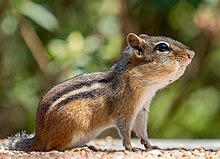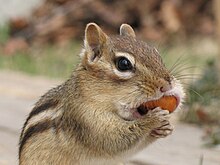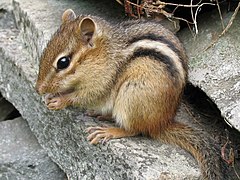Chipmunk
| Chipmunk Temporal range: Early Miocene to Recent
| |
|---|---|

| |
| Eastern chipmunk (Tamias striatus) | |
| Scientific classification | |
| Domain: | Eukaryota |
| Kingdom: | Animalia |
| Phylum: | Chordata |
| Class: | Mammalia |
| Order: | Rodentia |
| Family: | Sciuridae |
| Subfamily: | Xerinae |
| Tribe: | Marmotini Illiger, 1811[1] |
| Genera | |
|
3, see text | |
Chipmunks are small, striped
Taxonomy and systematics
Chipmunks may be classified either as a single genus, Tamias, or as three genera: Tamias, of which the eastern chipmunk (T. striatus) is the only living member; Eutamias, of which the Siberian chipmunk (E. sibiricus) is the only living member; and Neotamias, which includes the 23 remaining, mostly western North American, species. These classifications were treated as subgenera due to the chipmunks' morphological similarities.[2] As a result, most taxonomies over the twentieth century have placed the chipmunks into a single genus. However, studies of mitochondrial DNA show that the divergence between each of the three chipmunk groups is comparable to the genetic differences between Marmota and Spermophilus,[2][3][4][5][6] so the three genera classifications have been adopted here.
-
Tamias striatus, Eastern chipmunk
-
Eutamias sibiricus, Siberian chipmunk
-
Neotamias minimus, Least chipmunk
The common name originally may have been spelled "chitmunk", from the native
Diet

Chipmunks have an
Ecology and life history

Eastern chipmunks, the largest of the chipmunks,[20] mate in early spring and again in early summer, producing litters of four or five young twice each year.[12] Western chipmunks breed only once a year. The young emerge from the burrow after about six weeks and strike out on their own within the next two weeks.[21]
These small mammals fulfill several important functions in
Chipmunks construct extensive burrows which can be more than 3.5 m (11 ft) in length with several well-concealed entrances.[23] The sleeping quarters are kept clear of shells, and feces are stored in refuse tunnels.[24]
The eastern chipmunk hibernates in the winter, while western chipmunks do not, relying on the stores in their burrows.[25]
Chipmunks play an important role as prey for various predatory mammals and birds but are also opportunistic predators themselves, particularly with regard to bird eggs and
Chipmunks typically live about three years, although some have been observed living to nine years in captivity.[27]
Chipmunks are diurnal. In captivity, they are said to sleep for an average of about 15 hours a day. It is thought that mammals which can sleep in hiding, such as rodents and bats, tend to sleep longer than those that must remain on alert.[28]
Genera
Genus Eutamias
- Siberian chipmunk, Eutamias sibiricus
- Eastern chipmunk, Tamias striatus
- †Tamias aristus
Genus Neotamias
- Allen's chipmunk, Neotamias senex
- Alpine chipmunk, Neotamias alpinus
- Buller's chipmunk, Neotamias bulleri
- California chipmunk, Neotamias obscurus
- Cliff chipmunk, Neotamias dorsalis
- Colorado chipmunk, Neotamias quadrivittatus
- Durango chipmunk, Neotamias durangae
- Gray-collared chipmunk, Neotamias cinereicollis
- Gray-footed chipmunk, Neotamias canipes
- Hopi chipmunk, Neotamias rufus
- Least chipmunk, Neotamias minimus
- Lodgepole chipmunk, Neotamias speciosus
- Long-eared chipmunk, Neotamias quadrimaculatus
- Merriam's chipmunk, Neotamias merriami
- Palmer's chipmunk, Neotamias palmeri
- Panamint chipmunk, Neotamias panamintinus
- Red-tailed chipmunk, Neotamias ruficaudus
- Siskiyou chipmunk, Neotamias siskiyou
- Sonoma chipmunk, Neotamias sonomae
- Townsend's chipmunk, Neotamias townsendii
- Uinta chipmunk, Neotamias umbrinus
- Yellow-cheeked chipmunk, Neotamias ochrogenys
- Yellow-pine chipmunk, Neotamias amoenus
In popular culture
- Alvin and the Chipmunks, an animated virtual band
- Chip 'n' Dale, cartoon Disney chipmunks
References
- ^ Illigeri, Caroli (1811). "Genus 34. Tamias (ταμιας promus condus) Bakkenhörnchen". Prodromus systematis mammalium et avium. Berlin: C. Salfeld. p. 83.
- ^ (PDF) from the original on 2019-06-08. Retrieved 2019-06-08.
- ^ Wilson, D. E.; D. M. Reeder (2005). "Mammal Species of the World". Archived from the original on 2007-06-23. Retrieved 2007-06-27.
- (PDF) from the original on 2012-08-23.
- (PDF) from the original on 2011-09-13.
- (PDF) from the original on 2018-04-30.
- ^ "Online Etymology Dictionary". Etymonline.com. Retrieved 7 December 2012.
- ^ Nichols, John D. and Earl Nyholm (1995). A Concise Dictionary of Minnesota Ojibwe. Minneapolis: University of Minnesota Press.
- ^ Audubon, John James; Bachman, John (1967). Imperial Collection of Audubon Mammals. New York: Bonanza Books, a division of Crown Publishing Group. p. 52.
- ^ Chisholm, Hugh, ed. (1911). . Encyclopædia Britannica. Vol. 12 (11th ed.). Cambridge University Press. p. 626.
- ^ Kryštufek, B.; B. Vohralík (2013). "Taxonomic revision of the Palaearctic rodents (Rodentia). Part 2. Sciuridae: Urocitellus, Marmota and Sciurotamias". Lynx, N. S. (Praha). 44: 22.
- ^ ISBN 978-0-8166-0952-9.
- ^ a b c "West Virginia Wildlife Magazine: Wildlife Diversity Notebook. Eastern chipmunk". Wvdnr.gov. Retrieved 2012-12-07.
- ^ "Eastern Chipmunk - Tamias striatus - NatureWorks". Nhptv.org. Retrieved 2012-12-07.
- ^ Linzey, A.V.; NatureServe (2008). "Tamias minimus". IUCN Red List of Threatened Species. 2008. Retrieved 2012-08-29.
- ^ Linzey, A.V.; NatureServe (2008). "Tamias sibiricus". IUCN Red List of Threatened Species. 2008. Retrieved 2012-08-29.
- ^ Linzey, A.V.; NatureServe (2008). "Tamias townsendi". IUCN Red List of Threatened Species. 2008. Retrieved 2012-08-29.
- ^ "Chipmunks | Living With Wildlife". Mass Audubon. Archived from the original on 2012-12-18. Retrieved 2012-12-07.
- ^ "Chipmunk at Animal Corner". Animalcorner.co.uk. 2004-01-01. Retrieved 2012-12-07.
- ^ "National Geographic". National Geographic Society. 11 April 2010. Archived from the original on 2021-03-01.
- ISBN 978-0-8262-1359-4.
- ISBN 978-1-55963-078-8.
- ^ Saunders, D. A. (1988). "Eastern Chipmunk". Adirondack Mammals. Adirondack Ecological Center. Retrieved 2015-09-19.
- ISBN 9780801886829. Retrieved 2015-09-19.
- ISBN 978-0-691-14092-6.
- ^ Sullivan, Janet. "WILDLIFE SPECIES: Sialia currucoides". Fire Effects Information System, [Online]. U.S. Department of Agriculture, Forest Service, Rocky Mountain Research Station, Fire Sciences Laboratory. Retrieved 23 January 2016.
- ^ "Information on Chipmunks". Essortment.com. 1986-05-16. Archived from the original on 2012-12-22. Retrieved 2012-12-07.
- ^ "40 Winks?" Jennifer S. Holland, National Geographic Vol. 220, No. 1. July 2011.
- ^ Tamias, Mammal Species of the World, 3rd ed.
Further reading
- Baack, Jessica K. and Paul V. Switzer. "Alarm Calls Affect Foraging Behavior in Eastern Chipmunks (Tamias Striatus, Rodentia: Sciuridae)." Ethology. Vol. 106. Dec. 2003. 1057–1066.
- Gordon, Kenneth Llewellyn. The Natural History and Behavior of the Western Chipmunk and the Mantled Ground Squirrel. Oregon: 1943
External links
- Wildlife and Nature – Chipmunk at the Wayback Machine (archived April 24, 2008)



